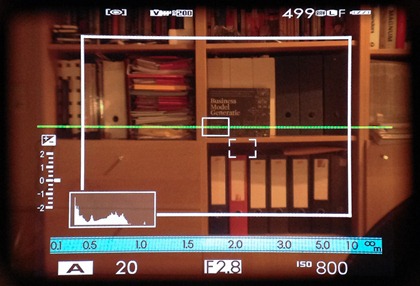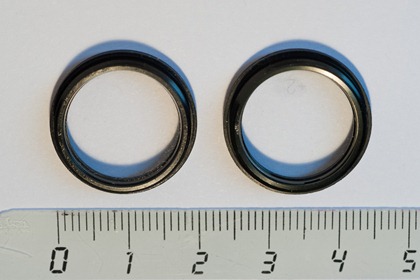I never intended for this blog to be about technical issues, but I guess my recent ‘quest for the optimal diopter’ may be of interest to many X-Pro1 owners.
Is there a problem?
The Fujifilm X-Pro1, unlike most recent cameras, does not come with any built-in means to adapt to its owner’s eyesight. Whether that is the result of some technical limitation linked to its unique hybrid viewfinder design, or as one more way to add to the retro look and feel, who but Fuji’s engineers can tell? The end result anyway is that many people with less-than-perfect vision - and especially those keeping on their glasses while shooting – will not be able to have a uniformly sharp look through the viewfinder, be it in optical (OVF) or electronic (EVF) mode.
Adding insult to injury, those using progressive lenses face another handicap: they will see the top and bottom of the viewfinder image with a different degree of sharpness, as their glasses’ corrections vary from top to bottom as well.
And then alas, there’s more… In OVF mode, electronic information is displayed on top of the direct optical view. The Fuji engineers for some reason have decided to ‘project’ the two images at different apparent distances. Some estimate that the optical image appears at about 1.5-2 meters, whereas the electronic overlay (and, in EVF mode, the full viewfinder image) lies closer.
Is there a solution?
The viewfinder comes equipped with a screw-in clear protection glass with zero correction. How do I know? If you remove the part and hold it over e.g. text on a page, the image seen through the glass does not shift when the glass is moved around.That ‘neutral’ eyepiece can be replaced by a diopter, a lens with a positive or negative correction factor just like eyeglasses. The X-Pro1 accepts a 19 mm diameter screw-in type diopter, the same type as once used by Voigtlander Bessa cameras, or older Nikon F (FE, FM, FA…) series SLR bodies. If your photography history goes back far enough, you might have some lying around in a drawer. Otherwise, you can go hunt for them at the handful of specialized camera shops that still carry or cater to (used) rangefinder cameras. As these diopters recently became a hot item overnight, you will likely find them back-ordered from the manufacturer: prepare for another patient wait… (remember the anticipation for your camera to arrive?).
What diopter correction do you need?
Correction eyepieces typically come in -3, –2, –1, +1, +2 and +3 diopter strengths (a 0-D part has no correction and serves as a replacement for a lost neutral glass).
If you know the details of your eyeglass prescription, you may try to do the math. Take into account that by design the X-Pro1 viewfinder has a built-in correction of –1, as confirmed by Fuji support sources. That value has been known to work best for the ‘average’ photographer (know any?), and also was the default with the older Nikon SLRs; Leica M-series cameras come preset to a –0.5 strength. It’s not impossible to calculate the desired correction, but nothing will work better (or at least, prove to be more reliable) than a real eyes-on test.
Better swing by your local optician and look into the viewfinder through the correction lenses they always keep handy. Test first with an EVF display (or call up the Q menu), then switch from EVF to OVF. Do this while wearing your glasses, of course, if you plan to keep them on while shooting. You will be able to verify the perceived image under different circumstances (OVF, EVF).
I myself cheated. Being nearsighted, I knew I needed a positive correction *. I recently have liberated a set of three Hoya close-up filters (in +1, +2 and +4 strengths) from the drawer where they had long retired. Every accessory I have with a 52mm filter thread has become popular again: once Nikon’s standard thread for basic prime lenses, this size is now used on the Fuji XF 18mm and 35mm lenses. So I had a set of trial diopters ready at hand (and a lot of filters as well).
* Just to be clear: nearsighted (myopic) people need a negative correction from their eyeglasses for distance viewing. For more nearby objects, that correction typically (and over age) will be weaker, maybe even zero for very short distances. Progressive lenses therefore add a positive ‘counter’ correction kicking in across the lower half of the eyeglasses. And as I want/need to keep my glasses on for shooting, I need a positive correction on top of the bigger negative one already built into them.
Where do you find one?
I ordered my Voigtlander +2 round diopter correction lens online from www.robertwhite.co.uk. They are sold at an acceptable GBP 15.00 excl. 20% VAT; too bad the cheapest delivery method, signed-for air mail, adds another GBP 10.50 excl. VAT. Reported out of stock at the time of my order, the diopter still came in pretty fast and showed up at home this morning.
The Voigtlander diopter looks remarkably like the original Fuji eyepiece. I would not be surprised if they shared a manufacturing line somewhere East. Fortunately, the diopter glass has a discrete reflective (in my case) +2 marking, barely visible in the above (click to enlarge) picture. The diopter has the same nice rubber coated ring as on the original: ideal for eyeglasses. Beware that the Nikon diopters have metal rings!
Do diopters work well?
Of course they do! With my diopter installed, I have a perfectly sharp view on the entire viewfinder area. Well, at least on the electronic overlay part and – when enabled – on the EVF image. Which is what I find most critical: the EVF is used for an exact display of the frame-to-be-captured, and also for macro shots and for fine tuning (manual) focus, with or without the optional enlargement. There is a small but noticeable difference between top and bottom sharpness, but of course that’s due to my use of progressive eyeglasses (there’s no progressive diopters that I know of…).
However, the OVF image showing at a different apparent distance now is slightly more out of focus. Not all too critical, since the OVF frame lines are approximate anyway, and all of the electronic data still looks tack sharp.
So I managed to reach my objectives, and finally have a super view through the super viewfinder of a super camera.
Just to be 100% convinced that I did not overcompensate with a +2 correction, I also did order a +1 diopter now (see? I should have taken a better look to begin with!). I will evaluate both options in real-life use, and perhaps one of the diopters will find another home then. Will take some time: the +1 is on back order…
Gear notes: D700, Tamron 90/2.8 – iPhone 4S
Click on the image(s) to see a larger version



2 comments:
Nice write-up. Sounds like you found a solution you can live with. I've been struggling for a week to resolve this issue. With a +2 diopter, I can get the focus tack sharp in the EVF (joy!), but then the OVF is frustratingly blurry. With no diopter, the OVF is sharp, but the EVF is blurry. I'm nearsighted (about -3.50 in each eye with a 1.50 add for reading) and I shoot with my glasses on of course.
What mystifies me is how the X100 (with an adjustable diopter), is fine for me. One of the key advantages of the X cameras is the hybrid view finder, but for eyeglass wearers, it seems only one viewfinder will work as promised. It seems to be a huge blunder on Fuji's part. If I can't get this resolved shortly, I am going to return my camera. Pity, because the image quality is far superior to my Nikon pro DSLR with top-of-the-line glass.
I guess everyone will have to make their own determination if they can live with a crippled viewfinder on the X-Pro 1. I say it's worth trying, but not worth spending your lifetime fixing.
I agree the + dioptre is the way to go if you wear spex for distance (-3 in my case). To DIY I bought a pair of cheap reading spex with +1 correction from the chemist and simlpy cut one of the acrylic lenses (out of the frames) to fit the viewfinder mount. You can cut to rough size with a modelling saw and fine tune the shape by filing down. No need to remove the existing glass lens - just mount your new dioptre between it and the body - there seems to be enough space. I found the +1 OK but you could try +1.5 or +2.
Post a Comment